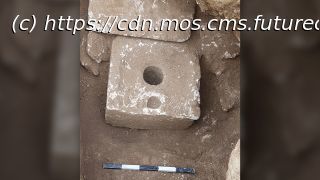A fecal analysis from two toilets dating to biblical times in Jerusalem has revealed the oldest evidence yet of the parasite that causes dysentery.
By analyzing poop from biblical-era toilets in Jerusalem, archaeologists have discovered the oldest known evidence of a tiny parasite that causes “traveler’s diarrhea,” a new study finds.
This microscopic parasite, the protozoan Giardia duodenalis, can cause dysentery, an intestinal infection that results in severe, bloody diarrhea and is often accompanied by stomach cramps and a fever. The new research, published May 26 in the journal Parasitology, dates the oldest evidence of this protozoan in human feces to more than 2,500 years ago.
The researchers discovered evidence of G. duodenalis under stone toilet seats previously found at two large sites that were likely elite residences dating to the seventh to sixth centuries B.C. The stone blocks had a curved surface for sitting, a large central hole for defecating, and a smaller hole that was possibly for urination, and were situated above a cesspit. Because the ancient toilets were still in their original locations, a unique opportunity arose for specialists to identify microorganisms in the old poop.
Previous research into the cesspits has revealed eggs from whipworms, roundworms, pinworms and tapeworms, suggesting that Iron Age sanitation practices were lacking. But while these eggs are robust and can preserve for thousands of years, it is much more difficult to detect the fragile cysts produced by protozoa.
Home
United States
USA — IT 2,500-year-old poop from Jerusalem toilets contain oldest evidence of dysentery parasite






